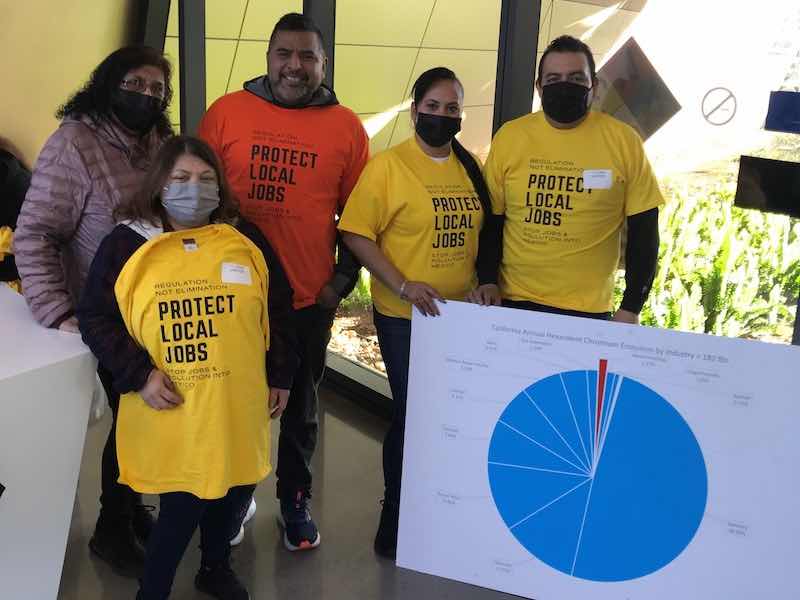Aviation Repair Solutions owner Jim Meyer wrote 27 letters to the California Air Resources Board when it proposed banning hex chrome finishing in the state.
 Jim Meyer from Aviation Repair Solutions.He also showed up at the Jan. 27 meeting — along with dozens of other shop owners and employees— to express his displeasure to the CARB members on the proposal they claim will put them out of business.
Jim Meyer from Aviation Repair Solutions.He also showed up at the Jan. 27 meeting — along with dozens of other shop owners and employees— to express his displeasure to the CARB members on the proposal they claim will put them out of business.
“I get 120 seconds to get you to understand that a ban is a death sentence for this business,” Meyer told the board, which limited speakers to just two minutes.
More than 150 members of the finishing industry attended a hearing in California where an air quality board will decide the fate of hard and decorative chrome plating in the state.
The Jan. 27 hearing in front of CARB was to consider proposed amendments to the Airborne Toxic Control Measure for Chromium Electroplating and Chromic Acid Anodizing Operations.
Plan to Ban Hex Chrome Facilities
CARB is proposing to ban new facilities later this year and phase out existing hexavalent chrome facilities beginning in 2023. Among the proposed directives:
- Ban any new chromium electroplating and chromic acid anodizing operations starting after Jan. 1, 2024.
- Adding new requirements on Jan. 1, 2026, for hard plating and chromic acid anodizing facilities that implement building enclosure, new emission limits, install controls on qualifying tanks, and new source testing.
- Phase out the use of hexavalent chromium in decorative plating by Jan. 1, 2027
- Phase out the use of hexavalent chromium in functional plating (hard plating and chromic acid anodizing) by Jan. 1, 2039.
Meyer says he worked at Boeing for over 23 years before borrowing money against his own home and opening Aviation Repair Solutions in West Long Beach in 2005.
“There’s no residential population there at all,” Meyer told the board. “I’m next to the port, the railroad, some refineries, and 5,000 diesel trucks. I bought a state-of-the-art HEPA control system, and we began repairing flight-critical aircraft parts.”
Aviation Repair Solutions emits two grams of chrome per year, Meyer says, the equivalent of “two paperclips.” He says his company has never used PFOS or PFAS and that they now face extinction because of the proposed ban.
“We employ 15 skilled craftsmen from the local community and buy medical, dental, and retirement plans for them and 30 more dependents,” Meyer says. “We’ve operated for 16 years through a pandemic and the great recession. Now I get 120 seconds.”
'Terminated in 2039 and on Death Row'
Meyer argued that if the proposed ban were approved, his Aviation Repair Solutions “will be terminated in 2039 and be on death row for the next 16 years. You are important people deciding the winners and losers; you’re also being deceived.”
CARB’s AB 617 requires air districts to prepare an annual report summarizing the results and actions for each community emissions reduction program (CERP), and Meyer says it is a good process whereby local communities have a say about pollution.
“I’m on the board of the Westside Business Association of Long Beach, and Westside, Wilmington, and Carson were the first AB 617 communities,” he says. “The CERP they wrote did show concern for hex chrome, but did not identify chrome platers as the problem.”
In fact, Meyer told the CARB members that five of the first six AB 617 communities did not identify chrome platers as the hex chrome problem, but one did.
“So now we’re going to get a non-local statewide ban imposed because of a local situation in one area,” he says. “It was not the intent of AB 617 to steamroll community decisions, but it is costing jobs in West Long Beach and Carson.”
Meyer’s frustration was shared by many other finishing shop owners and managers who followed him to the podium.
Art Holman is the owner of Sherm’s Custom Plating in Sacramento, which specializes in helping hot rod and car enthusiasts make their vehicles shine as well as protect them from corrosion
“I am what is being deemed a so-called ‘decorative plater,’ but I dispute that term because the process that I provide is very functional,” Holman says. “I also provide mil=spec plating on medical equipment, and I also have to adhere to OEM specifications for historical automotive repair and refurbishing.”
Holman told the CARB board that its staff has not taken into account here is the amount of ‘leakage’ that is going to happen in jobs from this proposal in the decorative plating industry.
“It is substantial,” he says. “There’s no way that I can transition to a trivalent process and maintain my business. If that were an option for me, I would gladly do so.”
Very Elevated Calculations
 Art Holman of Sherm’s Custom Plating.Holman also told the CARB board that the numbers that their staff presented to them on the emissions that are generated in the decorative and functional plating are very elevated. He says the calculations were done using maximum throughput at maximum allowable emission rates.
Art Holman of Sherm’s Custom Plating.Holman also told the CARB board that the numbers that their staff presented to them on the emissions that are generated in the decorative and functional plating are very elevated. He says the calculations were done using maximum throughput at maximum allowable emission rates.
“These numbers are not accurate,” Holman testified. “Our emissions are much lower than what has been presented.”
Holman, who has been in the plating industry for 43 years, says he has 10 employees. They all have very good homes, jobs, and health benefits that will be lost if the proposal is approved.
“The plating that I do with my facility will be moved out of state, and we will incur diesel exhaust and particulate matter,” he says.
Frank Grana, General Manager of California Electroplating in Los Angeles, told CARB that he has come to the impression that the board members think that trivalent chrome is a direct replacement for hexavalent chrome in the decorative industry.
“I’m here to tell you it is not,” Grana says. “Hexavalent chrome gives a color that trivalent chrome has not achieved at this point. I have many customers that tell me that they like the idea of going with a less toxic chemical, but the color is just not there. And color is decorative.”
Grana says California Electroplating — which has been around for over 100 years — will lose 45% of its business if the proposal is passed. He says it will cause him to eliminate 30 jobs at his shop, too.
“I would ask the board to postpone the banning of hex chrome until trivalent chrome improves,” he says. “When trivalent chrome can match the look of hexavalent chrome, I will gladly get rid of hexavalent chrome. It’s overkill and unnecessary to shut down an industry that is already heavily regulated.”
Shop Workers Testify as Well
 Ricardo OsarioAlong with owners and managers, some plating shop employees testified they feel safe working in the facilities and that they have even brought on family members to work there, too.
Ricardo OsarioAlong with owners and managers, some plating shop employees testified they feel safe working in the facilities and that they have even brought on family members to work there, too.
Ricardo Osorio testified that he has been working in a plating facility for almost 34 years, and both of his sons are now working in the same facility, one for over 14 years and the other for close to seven years,
“I’m in charge of over 100 employees, and we have employees working in there for more than 40 years,” Osorio testified. “One just retired at 72 years old, and he still was trying to come back to work part-time. So we are here to ask for us to keep our jobs.”
Jesse Arias works for EME Plating in Compton, a job he has held since 2017. He recently helped get his son a job at the company, which recently spent over $250,000 to add controls on passivation tanks and chrome sealers.
“The source testing was very expensive, but it proved over and over that the emissions were next to zero,” he says. “You guys talk about disadvantaged communities, but we have lived there in Compton my whole life. These companies have given us an opportunity to better ourselves. The rules you want to put in place it is going to ruin a lot of us. So I asked you guys to please reconsider that.”



































